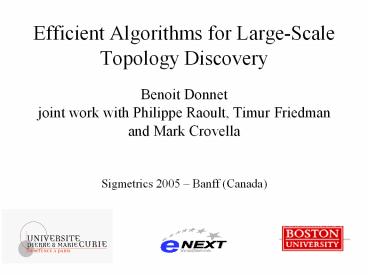Efficient Algorithms for Large-Scale Topology Discovery - PowerPoint PPT Presentation
Title:
Efficient Algorithms for Large-Scale Topology Discovery
Description:
Efficient Algorithms for Large-Scale. Topology Discovery. Benoit Donnet. joint work with Philippe Raoult, Timur Friedman and Mark Crovella. Sigmetrics 2005 Banff ... – PowerPoint PPT presentation
Number of Views:31
Avg rating:3.0/5.0
Title: Efficient Algorithms for Large-Scale Topology Discovery
1
Efficient Algorithms for Large-ScaleTopology
Discovery
- Benoit Donnet
- joint work with Philippe Raoult, Timur Friedman
and Mark Crovella - Sigmetrics 2005 Banff (Canada)
2
Context
- Network measurement
- Internet topology discovery using distributed
traceroute monitors - IP interface level
- Existing tools
- Skitter (CAIDA)
- TTM (RIPE NCC)
- AMP (NLANR)
- DIMES (Tel Aviv U.)
3
Scaling Problem
- More monitors means more load on
- network resources
- destinations
- Classical approaches either
- stay small (skitter, TTM, AMP)
- trace slowly (DIMES)
- Can we trace more efficiently?
4
Contributions
- Quantification of scaling problems
- Intra-monitor redundancy
- Inter-monitor redundancy
- Efficient cooperative topology discovery
algorithm - Doubletree
5
Intra-monitor Redundancy (1)
6
Intra-monitor Redundancy (2)
7
Inter-monitor Redundancy (1)
8
Inter-monitor Redundancy (2)
9
Doubletree Tree-like Structure of Routes
- Both redundancy (i.e. inter and intra) suggest
two different probing schemes - They are based on the tree-like structure of
routes - Intra-monitor
- monitor-rooted tree (first suggested by Govindan
et al.) - Inter-monitor
- destination-rooted tree
10
Doubletree Monitor-rooted Tree
11
Doubletree Destination-rooted Tree
12
Doubletree Reconciliation
- Backward and forward probing are opposite schemes
- How can we reconciliate them?
- Starts probing at some hop h
- First, performing forward probing from h
- Second, performing backward probing from h-1
13
Doubletree Stop Sets
- Not necessary to maintain the whole tree
structure. - Each monitor uses stop sets (interface, root)
- Local Stop Set B interface
- Backward probing
- Global Stop Set F (interface, destination)
- Forward probing
- Shared between monitors
14
Doubletree Results (1)Intra-Monitor
skitter
Doubletree
15
Doubletree Results (2)Inter-Monitor
skitter
Doubletree
16
Conclusion
- We point out redundancy in classical topology
discovery approaches using two metrics - Intra-monitor redundancy
- Inter-monitor redundancy
- Based on these metrics, we define the Doubletree
algorithm - Measurement load reduction up to 76
- Interface and link coverage above 90































